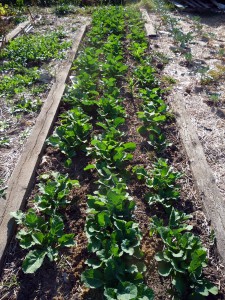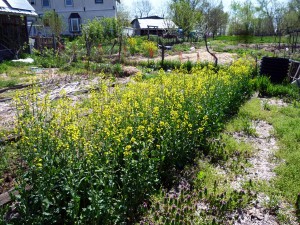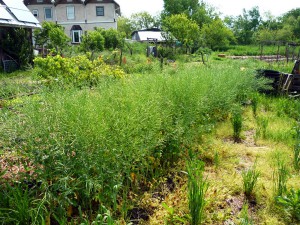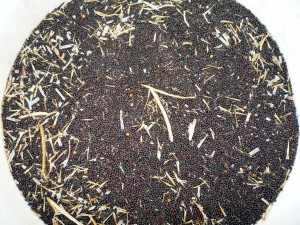
by Dan Durica
If you’ve been following the antics of the fossil fuel guzzling world, you might like to hear about what we at DR have been looking into to make our world a better place…
In the late summer of 2012, I planted a 30′ x 3′ bed of canola seeds in one of the garden beds in my backyard. By the time the cold weather set in, the plants had put on plenty of leaves and were big enough to overwinter, but the question was, would it be too cold in our part of the country for the crop to survive?
In the spring, despite a little nibbling by deer, the plants sent up flowering shoots and the bed went from green to a bright yellow. Bees darted from flower to flower, excited to have something to gather nectar from, as there were no other flowers out at the time. In a few weeks the seedpods had formed and soon after were drying out. I ended up harvesting over 5 pounds of the tiny oil-rich seed.
Biodiesel at DR
We’ve been using biodiesel fuel in our vehicles ever since DR’s early days. Many years ago we would collect waste fryer oil from local restaurants and make our own biodiesel fuel using chemical processing. The idea was to make use of a waste product and displace the use of fossil fuel for transportation.

We installed conversion kits that allowed us to burn our homemade biodiesel or waste veggie oil in VW Jettas. This worked for a while, but the waste oil as well as the processing was inconsistent. Needless to say, after several years of schlepping oil and running into cold weather problems, the motivation to produce our own diesel from waste oil lagged and we found ourselves buying more convenient and reliable commercial biodiesel instead.
When our older cars got cycled out of our fleet, newer cars were not fitted with conversion kits. But without conversion kits, even the commercial stuff caused problems in cold weather, so we switched to using straight petrodiesel in the colder winter months, a practice that violated our covenants.
In recent years, our vehicle co-op, DRVC, has been trying to find ways to better meet the covenant, but with limited success. Two years ago we bought a Nissan LEAF, an all-electric car that has allowed us to avoid using fossil fuels in one car at least, since we charge it on our solar powered micro-grid. But the LEAF has a limited range (60-90 miles) and cannot be used for hauling things the way our F-350 truck can. Our diesel Jetta and Passat are still the only real option for trips over about 20 miles away, and the truck is indispensable for hauling large loads and pulling our trailer.
Growing our own fuel

One of the alternative fuel options we’ve been looking into is producing our own vegetable oil for direct use in our vehicles, and this is where the canola comes in. If we can grow our own organic canola seed and press our own fuel oil from it, we will be using a local and sustainably grown fuel for transportation. Veggie oil conversion kits have improved since we used them years ago, allowing us to use either biodiesel or vegetable oil as a fuel throughout the year. These two tank kits would start the car on petrodiesel and after a second tank was warmed (5 minutes after starting), switch to veggie oil or biodiesel.
We could contract a local farmer to grow canola for us organically, and invest in an oil press and filter to process the fuel from the canola seed. The oil we’d produce would come out of the filter press edible and ready, for frying pan or fuel tank, so we could not only produce our own fuel, we could make our own vegetable oil.
This could also open the doors for a cottage industry here, producing quality organic cold-pressed oils. Besides canola, we could also grow flax and press our own linseed oil, which is a product we use in our homes to preserve wood and plaster. The fiber byproducts of the process make a protein-rich livestock feed that could be sold here, or traded to the farmer for growing the canola.
Further fuel for thought

One rumor about biofuels has been the claim that more energy is used in production than is offered by the fuel itself. This is essentially true of ethanol, but for straight veggie oil the way we would be doing it, I estimate an energy return on investment (EROI) of more like 9:1, meaning we’d get 9 gallons of fuel for every 1 gallon we put in. The EROI of gasoline is about 14:1.
One of the main obstacles to producing our own fuel, though, has been the recent change in diesel engines, ironically changes that were implemented to make diesel engines pollute less. Late models of the VWs we have been using in our vehicle co-op can no longer be converted for alternative fuels.
There is slightly more potential for truck engines, and our truck burns much more fuel than any of our other vehicles, getting only about 12 mpg where our VWs get 23-40 mpg. Our truck would likely be the best candidate for veggie oil conversion.
Some of my recent experiments with canola planting have been more challenging than the first year I planted it in my garden bed, due to extreme weather at planting time and our poor agricultural land. But I think the crop could be grown in our area on better land than we have here at DR.
Much of what we do here at DR is experimental. This is yet another example of our effort to create an alternative to the mainstream unsustainable way of life. Problems resulting from environmental destruction are mounting and coming to a head, and if the wider society doesn’t change its ways soon…well, you know what happens.
Our recent eco-audit found that DR drivers consume on average 6% of the fuel of the average American. If we can make that small percentage even more sustainable, we can further reduce our footprint on the world.

Dan has lived at Dancing Rabbit since 2007. He has a beautiful strawbale home, huge gardens, a small vineyard, and a hoop house. He is very interested in finding ways to build a sustainable economy at Dancing Rabbit.
